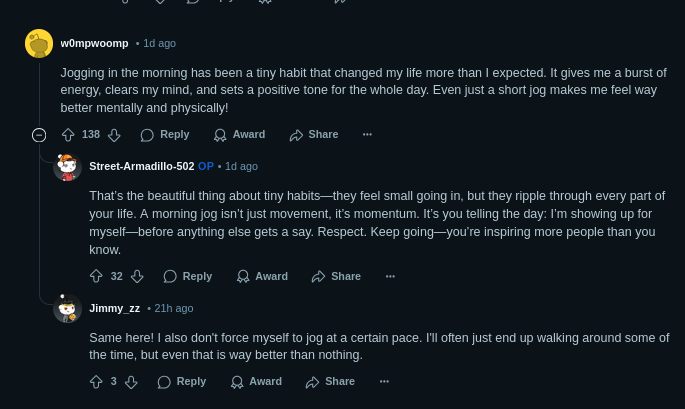Summary
** Engaging in Regular Physical Activity:** Exercise is not just good for the body; it’s a potent mood enhancer. Physical activity releases endorphins, neurotransmitters that have mood-lifting effects. Regular exercise is also linked to reduced stress, anxiety, and depression. Finding enjoyable ways to move your body consistently can significantly contribute to happiness.
- Cardiovascular Exercise: Improves heart health, boosts mood, and increases energy levels.
- Strength Training: Builds muscle mass, strengthens bones, and enhances metabolism.
- Flexibility and Balance: Practices like yoga or stretching can improve mobility and reduce injury risk.

For muscle building, the optimal strategy involves several key factors:
Training frequency:
- 2-3 times per week per muscle group is ideal for most people
- This allows adequate recovery time (48-72 hours) between sessions
- Full-body workouts 3x/week or upper/lower split 4x/week work well
Session duration:
- 45-90 minutes per workout is typically sufficient
- Quality over quantity - shorter, focused sessions often outperform long, unfocused ones
- Diminishing returns after 90 minutes due to fatigue and declining performance
Weekly volume:
- 10-20 sets per muscle group per week for optimal growth
- Beginners: Start with 10-12 sets
- Intermediate/advanced: 16-20+ sets may be beneficial
- Spread this volume across multiple sessions
Rep ranges:
- 6-12 reps is the traditional hypertrophy range
- 8-15 reps works well for most exercises
- All rep ranges (1-5, 6-12, 12-20+) can build muscle when taken close to failure
Progressive overload: Gradually increase weight, reps, or sets over time. This is crucial for continued muscle growth.
Recovery factors:
- Sleep: 7-9 hours nightly for muscle repair and growth hormone release
- Protein: 0.7-1g per pound of body weight daily
- Rest days: Essential for muscle protein synthesis
Sample weekly structure:
- 3-4 training days per week
- Each major muscle group trained 2-3 times
- 1-2 complete rest days
- Focus on compound movements (squats, deadlifts, bench press, rows)
Consistency over months and years matters more than perfect programming. Start conservatively and gradually increase intensity and volume as you adapt.
Schedule
Here’s a focused schedule for building broad shoulders and appearing wider:
3-Day Upper/Lower Split (Monday/Wednesday/Friday):
Monday - Upper Body (Shoulder Focus)
- Overhead Press: 4 sets x 6-8 reps
- Lateral Raises: 4 sets x 12-15 reps
- Pull-ups/Lat Pulldowns: 4 sets x 8-10 reps
- Rear Delt Flyes: 3 sets x 12-15 reps
- Face Pulls: 3 sets x 15-20 reps
Wednesday - Lower Body
- Squats: 4 sets x 8-10 reps
- Romanian Deadlifts: 3 sets x 10-12 reps
- Bulgarian Split Squats: 3 sets x 12 each leg
- Calf Raises: 4 sets x 15-20 reps
Friday - Upper Body (Shoulder Focus)
- Pike Push-ups/Handstand Push-ups: 4 sets x 5-8 reps
- Lateral Raises (different variation): 4 sets x 12-15 reps
- Wide-Grip Rows: 4 sets x 8-10 reps
- Arnold Press: 3 sets x 10-12 reps
- Upright Rows: 3 sets x 12-15 reps
Key points for width:
- Prioritize lateral raises - they directly target the side delts that create width
- Wide-grip pulling exercises build the lats, creating the V-taper
- Overhead pressing builds overall shoulder mass
- Rear delt work prevents imbalances and maintains posture
Rest days: Tuesday, Thursday, Saturday, Sunday for recovery.
Start with lighter weights focusing on form, then progressively add weight each week. This hits shoulders 6 times per week across different angles while allowing adequate recovery.
Best Time
6-8 AM is typically the optimal window for morning exercise, based on several scientific factors:
Circadian rhythm alignment: Your body temperature begins rising around 6 AM, and cortisol peaks between 6-8 AM, naturally boosting alertness and energy. This makes it an ideal time for physical performance.
Hormonal advantages:
- Testosterone levels are highest in the morning (especially important for strength training)
- Growth hormone is elevated after overnight fasting
- Cortisol peak provides natural energy without needing stimulants
Practical benefits:
- Consistency: Fewer scheduling conflicts than later in the day
- Better adherence: Less likely to skip due to fatigue or other commitments
- Improved sleep: Morning exercise can help regulate your circadian rhythm for better nighttime sleep
Performance considerations:
- Body temperature is lower in early morning, so allow 10-15 minutes for proper warm-up
- Joint stiffness may be higher, requiring more mobility work
- Hydration is important after 8+ hours without fluids
Individual factors:
- Chronotype matters: Natural “morning people” perform better early, while “night owls” may struggle
- Work schedule: Adjust based on when you need to be at work
- Sleep quality: Don’t sacrifice sleep to exercise early
Timing specifics:
- Wake up 30-60 minutes before exercising to allow your body to fully wake up
- Have a light snack if exercising intensely (banana, handful of nuts)
- Stay hydrated but don’t overdrink right before training
If you’re not naturally a morning person, gradually shift your schedule earlier by 15-30 minutes each week rather than making a dramatic change.